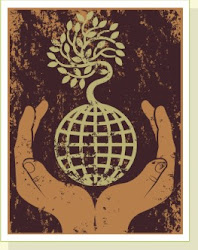Environmental Responsibility

Trees symbolize the environmental movement. With this in mind we operate our business with an eye towards minimizing our environmental impact and leaving the Austin environment cleaner and healthier than we found it.
Brush Recycling and Lumber Milling
All debris is brought back to our facility and recycled with a tub grinder. None of the brush is put into a landfill or incinerated. All wood that is suitable for lumber is milled into slabs and processed into useable wood for furnature, shelving, mantles, countertops and other art installations. All of the woody debris we produce winds up back in somebody's garden or as beautiful furniture in someone's home.Minimizing Fuel Usage
All Austin Tree Experts equipment purchases are made with fuel consumption in mind. The standard in the tree business is to use large, gas-guzzling dump trucks with inefficient wood chippers. At Austin Tree Experts we use smaller trucks and trailer our debris to our yard where a large tub grinder efficiently processes the mulch. Our trucks get better fuel efficiency than a standard tree service dump truck. We minimize the use of on-site wood chippers; these overworked machines are notorious for poor fuel efficiency and hydraulic failure that often result in oil spills.
Another benefit to not using on-site wood chippers is the elimination of air and noise pollution. These machines are extremely noisy and disturbing to your neighbors. Grinding all that wood also creates enormous amounts of dust. Eliminating these machines from the work site makes for a safer and more pleasant environment for you and your neighbors as well as for our employees.
Fertilizer and Pesticide Application
Our tree health program keeps pesticide application to a minimum by following the established principles of IPM (Integrated Pest Management) and only treating when the situation calls for it. We focus on maintaining healthy trees, thereby limiting the need for pest control. We train our technicians in distinguishing between normal levels of pest pressure and more serious infestations that threaten the health of the tree. We also stay up to date on the latest technology, using the least toxic products that can still achieve desired levels of control.
Our fertilization program uses extremely low rates of slow release nitrogen to minimize leaching and incorporates humates (the chemical components of compost) and mycorrhizae to improve uptake and the general health of the soil. By utilizing humic acids and mycorrhizae, we are able to drastically reduce our nitrogen application while still acheiving exceptional results.
